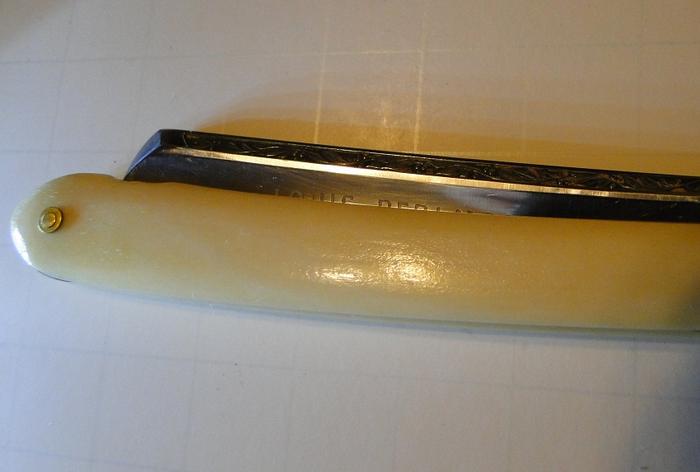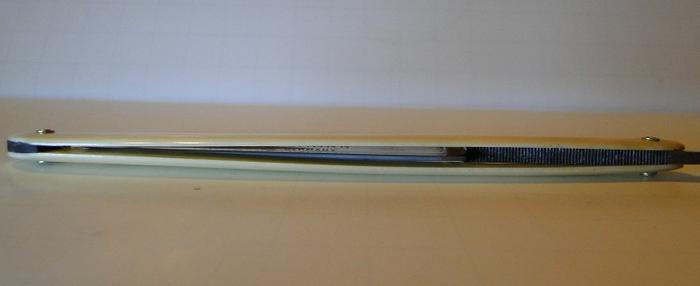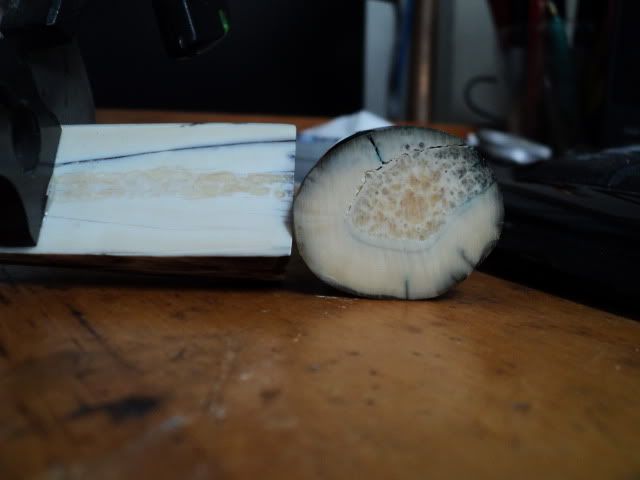Results 11 to 20 of 40
Thread: Identifying Ivory
-
06-19-2012, 04:55 PM #11Seņor Member (the name is Dave)


- Join Date
- Feb 2012
- Location
- Sarver, Pennsylvania, United States
- Posts
- 683
Thanked: 88
Thanks. I'm fairly sure these scales actually are ivory, but will need to check when I get home. You guys are great; I'm not bad a finding data online, but there is an awful lot of useless stuff out there about ivory, and this is a very usefull distilled set of information.
-
06-19-2012, 07:42 PM #12Thread derailment specialist.



- Join Date
- Dec 2011
- Location
- Republica de Tejas
- Posts
- 2,792
Thanked: 884
I have two razors with ivory scales. On both sets the scales are very thin. I would imagine that since you've cleaned and sanded yours that they are pretty much white now. Ivory yellows with age and handling. The grain in ivory is rarely ( from what I've seen ) like the lines you see in in faux or "French ivory which is celluloid. The celluloid has very regular grain in it whereas ivory is pretty random.
Here is a fairly close view of one.

and another view of another

a typical break

with a view of bone thrown in

-
06-19-2012, 08:00 PM #13Senior Member


- Join Date
- Jan 2011
- Location
- Roseville,Kali
- Posts
- 10,432
Thanked: 2027
Actually,seeing a crack at the wedge end is atypical.IME
-
06-20-2012, 12:16 AM #14
-
06-20-2012, 01:05 AM #15Seņor Member (the name is Dave)


- Join Date
- Feb 2012
- Location
- Sarver, Pennsylvania, United States
- Posts
- 683
Thanked: 88
Here are a couple of pics. I'm thinking they are ivory.


-
06-20-2012, 01:11 AM #16Senior Member


- Join Date
- Jan 2011
- Location
- Roseville,Kali
- Posts
- 10,432
Thanked: 2027
Not Bone,might be ivory,hard to tell,unusual pinning for Ivory scaled razors.
Maybe a re-scale.
-
06-20-2012, 01:22 AM #17Seņor Member (the name is Dave)


- Join Date
- Feb 2012
- Location
- Sarver, Pennsylvania, United States
- Posts
- 683
Thanked: 88
It is a re-scale. I did it and didn't know about any difference in pinning ivory vs other materials.
-
06-20-2012, 01:27 AM #18

Here is some ivory, cleaned up. I wish to know how many types of ivory, from different creatures, were used in scale construction, and how to tell the difference? The Shreger lines and their characteristics, or lack thereof, will tell! Counting on Pixelfixed for this!

-
06-20-2012, 01:56 AM #19Senior Member


- Join Date
- Jan 2011
- Location
- Roseville,Kali
- Posts
- 10,432
Thanked: 2027
Sorry, my bad,if you polish yours to a higher degree and rub in mineral oil the grain if present will be more defined like sharptonns above.Yours look like ivory and are thin like vintage scales,most likly are.
As far as the pinning,most vintage ivory scales were done without washers,thats a dead givaway on Heljes if re-scaled.
Scheregar lines only occur on Elephant Ivory,that incs mammoth.
If you look at Sharptonns beautiful examples. you can see the Grain patterns,they are the lenth wise pattern of the S.lines.But Ivory can be cut (like diamonds)in many differant ways to expose many diff. grains.
The ivory above(sharptonns) is cut from the very outer portion of the tusk (see my pic above)this is the gem quality Ivory and sells for at least 4 times the price of plain ivory because of the waste factor.
Am no expert but cutting Ivory is an exacting art,you can see that only a very small outer portion of the tusk is gem quality above.
Am certain than every known type of Ivory has been used for scales,I have only seen Elephant and Walrus.
are also alot of tusk type things that are called Ivory but nothing matches elephant or Walrus for beautifull grain.
Walrus being the king of them all and is very rare stuff, will look for a pic of some,all my stuff is packed away as we are re-locating.
-
The Following User Says Thank You to pixelfixed For This Useful Post:
DFriedl (06-20-2012)
-
06-20-2012, 02:21 AM #20Senior Member


- Join Date
- Jan 2011
- Location
- Roseville,Kali
- Posts
- 10,432
Thanked: 2027
This is Walrus,the inner grain looks like tapioca,is amazing material.

-
The Following User Says Thank You to pixelfixed For This Useful Post:
livingontheedge (06-20-2012)


 16Likes
16Likes LinkBack URL
LinkBack URL About LinkBacks
About LinkBacks






 Reply With Quote
Reply With Quote

